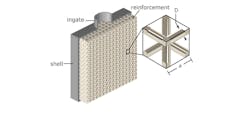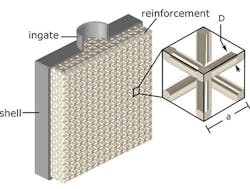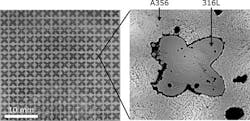Combining Casting with 3DP to Customize "Damage Tolerant" Parts
To date, product designers and manufacturers have viewed additive manufacturing as an alternative (or even a competitive threat) to more established forming processes, like molding or machining. And those assumptions are correct: AM or 3D printing can be used in place of casting parts, with advantages to be determined by the scale of production or the needs of a specific design. But, these technologies also can be used to optimize or improve aspects of the casting process, as in printing sand molds and cores, or defining and repairing casting molds.
But now it's possible to imagine additive manufacturing as a pathway to products and materials that were never conceivable, except as some designer's dream. Now, such dreams can be realized -- in the research lab, at least.
Researchers at Oak Ridge National Laboratory (ORNL) and Rice University have reported their results in developing a new approach to consolidating multiple materials into a single cast part, creating what they term "damage tolerant" components. They contrast their method to established metal 3D printing techniques (referred to as "fusion-based metal additive manufacturing"), which often achieve geometric design goals but fall short of mechanical or material requirements in a functional sense.
In details reported by the researchers, the two materials they combined were stainless steel and aluminum. Their two-stage process "infiltrates" a 316L stainless steel lattice structure with a molten aluminum alloy, A356. According to their report, the process helps to overcome "issues with intermetallic formation, cracking, and poor resolution" that are common in many metallic parts formed by standard additive manufacturing.
The first step developed by the Oak Ridge team involves producing a lattice preform structure in the stainless material using selective laser melting, an established metal additive manufacturing method. The lattice structure then is the framework of the finished part.
Researchers modified the shape and density of 3D-printed lattice structures to achieve desired material properties in composite metal castings.
In the second step, the frame is set within a permanent mold and then surrounded with a liquid metal at a melt temperature lower than that of the inset framework. The molten aluminum fills the space around the frame within the mold, and the resulting part is described as "interpenetrating phase composite" (IPC) that has a higher tolerance to damage than a comparable aluminum casting.
According to the process developers, these parts could have commercial application in automotive design and production, where lightweight parts with more optimized thermal and mechanical characteristics are needed. In designing such a part, the new two-step process could be used to tailor the desired thermal and mechanical properties needed for a specific final application.
Compression tests conducted on the stainless steel/aluminum part showed that adjusting the volume fraction and topology of the stainless steel lattice can control its stress-strain response. Also, according to the researchers, tension tests on composites with a 39-vol% of steel demonstrated "an order of magnitude improvement over the strain to failure" compared with the aluminum alloy on its own.
"Inspection of the as-tested tensile specimens suggested that this exceptional damage tolerance is a result of the interpenetrating structure of the constituents," the researchers wrote. "These results together demonstrate that this infiltration processing route avoids problems with intermetallic formation, cracking, and poor resolution that limit current fusion-based additive manufacturing techniques for printing metallic composites."
"This scalable processing strategy can be used to fulfill specific component functions, giving materials designers unprecedented control over both microstructure and material properties," stated Amit Shyam, one of the ORNL researchers and an author of the report.
"The key advantage of this processing strategy over other fusion-based metal additive manufacturing techniques is that in this two-step process, liquid-phase mixing of the constituents is excluded. As a result, we are able to overcome problems with cracking and poor resolution that limit most of the other fusion-based additive manufacturing techniques for printing composites," according to their report.
The research report, "Damage-tolerant metallic composites via melt infiltration of additively manufactured preforms" is available for download at http://bit.ly/2vNVdJr
About the Author
Robert Brooks
Content Director
Robert Brooks has been a business-to-business reporter, writer, editor, and columnist for more than 20 years, specializing in the primary metal and basic manufacturing industries. His work has covered a wide range of topics, including process technology, resource development, material selection, product design, workforce development, and industrial market strategies, among others.


